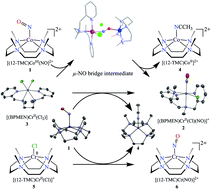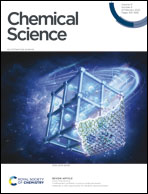Why intermolecular nitric oxide (NO) transfer? Exploring the factors and mechanistic aspects of NO transfer reaction†
Abstract
Small molecule activation and their transfer reactions in biological or catalytic reactions are greatly influenced by the metal-centers and the ligand frameworks. Here, we report the metal-directed nitric oxide (NO) transfer chemistry in low-spin mononuclear {Co(NO)}8, [(12-TMC)CoIII(NO−)]2+ (1-CoNO, S = 0), and {Cr(NO)}5, ([(BPMEN)Cr(NO)(Cl)]+) (4-CrNO, S = 1/2) complexes. 1-CoNO transfers its bound NO moiety to a high-spin [(BPMEN)CrII(Cl2)] (2-Cr, S = 2) and generates 4-CrNOvia an associative pathway; however, we did not observe the reverse reaction, i.e., NO transfer from 4-CrNO to low-spin [(12-TMC)CoII]2+ (3-Co, S = 1/2). Spectral titration for NO transfer reaction between 1-CoNO and 2-Cr confirmed 1 : 1 reaction stoichiometry. The NO transfer rate was found to be independent of 2-Cr, suggesting the presence of an intermediate species, which was further supported experimentally and theoretically. The experimental and theoretical observations support the formation of μ-NO bridged intermediate species ({Cr–NO–Co}4+). Mechanistic investigations using 15N-labeled-15NO and tracking the 15N-atom established that the NO moiety in 4-CrNO is derived from 1-CoNO. Further, to investigate the factors deciding the NO transfer reactivity, we explored the NO transfer reaction between another high-spin CrII-complex, [(12-TMC)CrII(Cl)]+ (5-Cr, S = 2), and 1-CoNO, showing the generation of the low-spin [(12-TMC)Cr(NO)(Cl)]+ (6-CrNO, S = 1/2); however, again there was no opposite reaction, i.e., from Cr-center to Co-center. The above results advocate clearly that the NO transfer from Co-center generates thermally stable and low-spin and inert {Cr(NO)}5 complexes (4-CrNO & 6-CrNO) from high-spin and labile Cr-complexes (2-Cr & 5-Cr), suggesting a metal-directed NO transfer (cobalt to chromium, not chromium to cobalt). These results explicitly highlight that the NO transfer is strongly influenced by the labile/inert behavior of the metal-centers and/or thermal stability rather than the ligand architecture.



 Please wait while we load your content...
Please wait while we load your content...